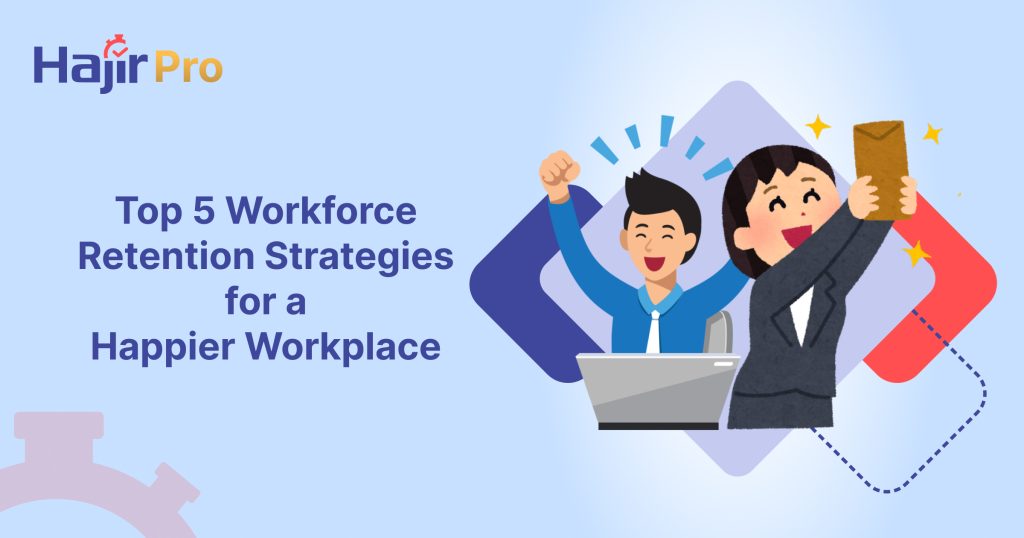Top 5 Workforce Retention Strategies for a Happier Workplace
In the current business environment, a major issue that companies face is retaining employees. Businesses invest a lot of time and money in attracting and training employees. However, dismissing employees quickly can lead to significant costs. This is the reason why successful workforce retention strategies are not only important but also crucial to the long-term success of a business.

If employees feel appreciated and are able to feel supported, cherished, and enthusiastic and appreciated, they tend to remain loyal to the business. However, poor management, the absence of opportunities for growth or a lack of recognition could encourage them to look for different opportunities. To reduce turnover and ensure a steady workforce, companies must implement successful strategies to increase the satisfaction of employees and build loyalty.
We’ll discuss the top 5 workforce retention strategies that will aid businesses in reducing employee turnover, increasing engagement and ensuring long-term viability.
What is Workforce retention strategies
Workforce retention strategies are strategies and methods employed by organizations to keep their employees happy and committed to their employer. They focus on reducing employee turnover through creating a positive workplace that provides reasonable compensation and benefits and career opportunities, acknowledging the contributions of employees and promoting a the work-life and family balance. Through the implementation of effective retention strategies, businesses will be able to ensure a steady, competent and motivated workforce that will ensure long-term achievement.
1. Provide Competitive Compensation and Benefits
A very crucial method to retain employees is to provide fair and competitive pay. People want the feeling that their work is appreciated and that they are rewarded accordingly. People tend to change jobs if they receive better wages or benefits elsewhere.
Key Practices:
- Verify the structure of your pay every few months to ensure that they are in line with the industry norms.
- Health benefits as well as retirement plans and insurance protection.
- Provide incentives and rewards based on performance.
- Help employees by providing pay-for-leave. Flexible hours, paid leave, and mental health tools.
Why It Works:
If employees feel financially secure and valued they are less likely to work outside of the company. An attractive package does not just attract the best talent but also helps ensure that current employees remain engaged and loyal.
2. Create Opportunities for Career Growth and Development
Nobody wants to remain in a position that makes them feel unfulfilled. The lack of professional development is among the main reasons why employees leave companies. Thus, one of the most effective methods of retaining employees is to offer education, mentorship and opportunities for growth.
Key Practices:
- Workshops for developing skills and certification courses.
- Encourage employees to accept new projects that test them.
- Mentorship programs are offered where high-ranking staff members mentor younger employees.
- Establish a clear career path by advancing your position and promotions.
Why It Works:
People who see a bright future in the business will be more likely to stay. If organizations invest in the growth of their employees, the employees feel valued and motivated to give more to the company.
The culture has a major impact on the retention of employees. A hostile work environment rife with a culture of resentment, harassment or poor communication can turn away employees regardless of how high the pay is. Establishing a positive and uplifting work environment is therefore an essential workforce retention strategy for workers.
Key Practices:
- Facilitate open dialogue between employees and managers.
- Promote teamwork, respect and inclusion.
- Recognize and reward employees for their achievements.
- Find a balance between work and life.
Why It Works:
People who feel content and respected at their job are more likely to remain. A positive environment builds trust, decreases stress, and boosts overall performance.
Everyone desires to feel like their efforts are appreciated. Reward and recognition are powerful workforce retention strategies that keep employees engaged and motivated. If employees aren’t valued and are unappreciated, it is more probable for them to quit or withdraw from the company.
Key Practices:
- Create employee recognition programs, like “Employee of the Month.”
- Be sure to provide timely praise and acknowledgement for achievements.
- Offer small rewards such as gift cards or paid time off or even team lunches.
- Celebrate milestones, such as anniversaries of work and other achievements.
Why It Works:
Recognition improves morale, increases productivity, and boosts loyalty of employees. If employees are aware that they are appreciated for their efforts and appreciated, they’re more dedicated to the success of the business.
Modern employees appreciate flexibility as much as a salary. The increase in hybrid and remote working has proven that employees prefer organizations that value their private life. The promotion of work-life balance is among the best workforce retention strategies of the moment.
Key Practices:
- Provide flexible working hours or remote work or hybrid options.
- Instruct employees on taking breaks and making use of their time off.
- Assist in Wellness programs and stress-management activities.
- Do not create a culture of excessive work and deadlines that are unrealistic.
Why It Works:
People who are flexible can be more relaxed, less stressed and more satisfied in their jobs. If companies respect the personal time of their employees, they feel appreciated as well as more inclined to remain loyal.
Apart from the top 5 strategies, here are some additional practices that enhance workforce retention:
- Good Leadership: Employees are the ones who leave management, not businesses. A good leader builds trust and participation.
- Feedback Systems: Regular feedback sessions and surveys assist in identifying issues with employees prior to them turning into resignations.
- Team-Building Events: Fun activities such as retreats and collaborative projects help strengthen working relationships.
- Fair Policies: Fair and transparent HR policies can prevent conflicts and dissatisfaction.
Retaining employees is not optional; it’s a requirement for the survival and growth of a business. A high turnover rate can cost you money as well as reduce productivity and harm the company’s reputation. By implementing these workforce retention strategies—competitive pay, career development, positive culture, recognition, and flexibility—organizations can build a loyal, motivated, and long-lasting workforce.
A happy and energized team is the core of a successful business. If employees feel valued, acknowledged, and loved they will be more likely to remain engaged and contribute to the vision of the company’s future.
If you’re a manager in a company or an HR manager, you should start using these methods today to cut down on employee turnover and guarantee long-term success.




